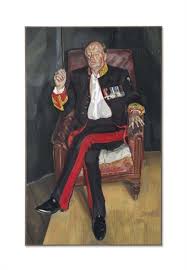The Ambassadors Hans Holbein the Younger 1533 © National Gallery London
Rene Magritte's paintings do this, unsettling the boundaries between logical reality and illusion with a visual paradox. This is a very clear example:
The Blank Signature Rene Magritte 1965 © National Gallery of Art, USA
 |
| How a blivet works |
I have always been puzzled by this painting of Walter Sickert's with the bars of the iron bedstead.
La Hollandaise (the Dutch Girl) W. R. Sickert 1906 © Tate Gallery London
Sickert uses flashes of light contrasting with the dark to manipulate the perspective, as in the right foot, and are they bars or shadows across the womans' head?
This reminds me of some of Lucian Freud's paintings and drawings. I am sure one of his earlier works shows a clearly drawn birdcage, in which some of the bird's body is outside the bars while the rest is inside the cage. Frustratingly I cannot find this image, but he also manipulates the viewer's expectations in his choice of subject:.
Chicken in a bucket Lucian Freud 1944 (Wikimedia)
Horse, Lucian Freud (Wikimedia)
Freud shared a love of horses with the subject of this portrait, Brigadier Parker-Bowles, but look how he has angled the obscured front leg of the chair on the line of contrast between dark and light, suggesting an unsettling tilt, and a sense of energy in the sitter:
The Brigadier Lucian Freud 2003-4 (wikimedia)
And this famous French impressionist painting is not at all as straightforward as it immediately seems:
A bar at the Folies-Bergere, Edouard Manet 1882 © Courtauld Gallery London
We look straight ahead at the barmaid in front of us, as if she and the viewer are standing in front of a large mirror, but is this so? Her reflection is at such a sharp angle, as are the bottles of champagne on the marble top, and where is that gentleman customer? Are these actually reflected, or are we looking at a whole other scene behind her?
"Yet one of the reasons the picture appeals as much as it does is that the spectator wobbles delightfully between looking forwards and seeing backwards." Jonathan Miller, On Reflection, National Gallery 1998
*see the detailed comments at artsy.net







No comments:
Post a Comment